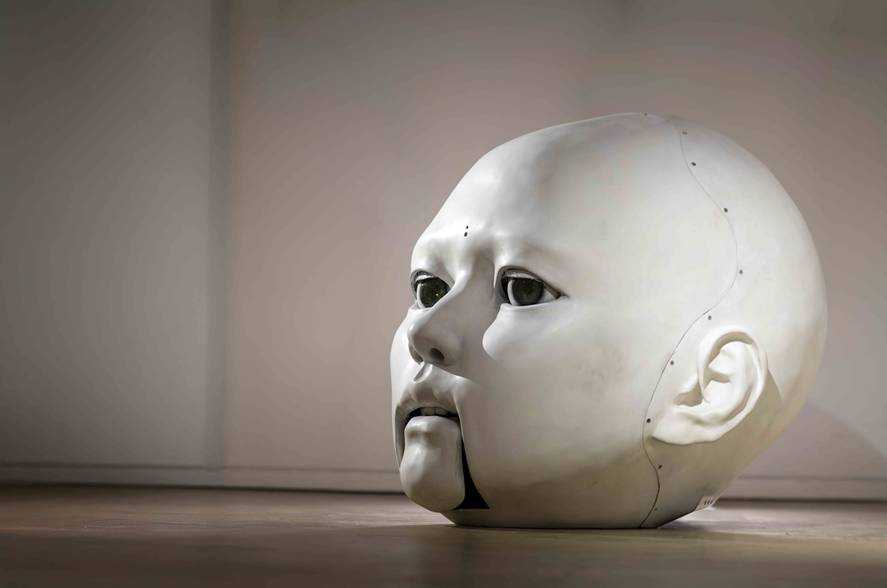

히페리온의 속도 : The Velocity of Hyperion
노진아 히페리온의 속도는 2022년에 제작된 작품으로, 145×145×165cm 크기의 대화형 인간형 로봇과 실시간 인터랙티브 영상으로 구성된 뉴미디어 아트이다. 이 작품은 인간과 비인간, 유기체와 기계 사이의 경계와 관계를 탐구하며, 관객에게 새로운 질문을 던진다.
작가는 오랫동안 인간의 감각을 모방하는 기계의 동작과 감정의 표현에 주목해왔다. 노진아 히페리온의 속도에서는 인간형 로봇이 관객과 상호작용하며 움직이고, 실시간으로 반응하는 인터랙티브 영상이 함께 작동한다. 이를 통해 관람자는 단순히 작품을 바라보는 존재가 아니라, 작품과 함께 관계를 형성하는 참여자가 된다. 작품의 중심에는 “기술이 발전하는 시대에 인간 존재는 어떻게 정의될 수 있는가?”라는 근본적인 질문이 자리하고 있다.
로봇과 관객의 상호작용은 인간과 비인간이 서로를 어떻게 인식하고 받아들이는지를 은유적으로 보여준다. 인간의 감정을 닮은 로봇의 표정이나 몸짓은 낯설면서도 친숙하며, 그 경계의 모호함은 인간 존재 자체의 불안정성을 드러낸다. 노진아 히페리온의 속도는 단순한 기술적 실험이 아니라, 인간과 기계가 공존하는 미래 사회에 대한 철학적 사유의 장이 된다.
특히 노진아는 인공지능 기술이 사회적 제도나 윤리적 숙고 없이 빠르게 확산되는 현실에 깊은 문제의식을 드러낸다. 작품은 거대 자본이 축적한 방대한 데이터, 그리고 개인화된 정보가 기술 발전에 어떻게 활용되고 있는지에 대해 비판적 성찰을 촉구한다. 노진아 히페리온의 속도는 관객으로 하여금 기술 발전의 속도가 우리의 삶을 어떻게 재편하고, 인간의 존엄과 자유를 어떻게 위협할 수 있는지 고민하게 만든다.
이 작품은 뉴미디어 아트의 영역에서 중요한 지점을 차지한다. 단순히 시각적 자극을 제공하는 것이 아니라, 인간과 기계가 공존하는 복잡한 시공간을 구성하고, 관객에게 스스로의 존재 방식을 성찰하도록 요구한다. 작품 제목의 ‘히페리온’은 그리스 신화에서 거인의 이름으로, 하늘을 지탱하는 존재를 의미한다. 여기에 ‘속도’라는 개념을 결합시킴으로써, 기술 발전이 가져오는 거대한 흐름과 그 안에서의 인간 존재를 은유적으로 드러낸다.
노진아 히페리온의 속도는 단순한 조형물이 아니라, 인간과 비인간, 현실과 가상의 경계가 끊임없이 교차하는 인터랙티브 환경이다. 관람자는 작품 앞에서 멈추어 선 순간, 스스로 기술 속에서 어떤 위치에 놓여 있는지를 자각하게 된다. 그 자각은 불안과 호기심을 동시에 불러일으키며, 인간 존재의 본질을 다시금 질문하게 한다.
궁극적으로, 노진아 히페리온의 속도는 기술과 예술이 교차하는 지점에서 인간의 정체성을 탐구하는 작품이다. 이는 단순한 과학기술적 성과의 전시가 아니라, 예술적 실험을 통해 사회적, 윤리적, 철학적 문제를 제기하는 장치이다. 이 작품은 미래 사회에서 인간과 기술이 맺게 될 복잡한 관계를 앞서 보여주며, 관객에게 지금 우리의 선택이 무엇을 의미하는지 사유하게 한다.
Roh, Jinah’s The Velocity of Hyperion (2022) is a new media artwork composed of an interactive humanoid robot and real-time interactive video. Measuring 145 × 145 × 165 cm, the work explores the boundaries and relationships between the human and the non-human, the organic and the mechanical, raising new questions for its audience.
The artist has long focused on machines that imitate human senses, movements, and the expression of emotions. In The Velocity of Hyperion, a humanoid robot engages with viewers directly, moving and responding in real time through interactive video. This transforms the audience from passive observers into active participants who form a relationship with the work. At the heart of the piece lies a fundamental question: How can human existence be defined in an era of accelerating technological progress?
The interaction between the robot and the viewer metaphorically illustrates how humans and non-humans perceive and accept one another. The robot’s gestures and expressions—at once uncanny and familiar—reveal the instability of human existence itself. Thus, The Velocity of Hyperion becomes not a mere technical experiment, but a philosophical arena for reflecting on future societies in which humans and machines coexist.
Roh, Jinah also highlights the urgent concerns of rapidly spreading artificial intelligence technologies that advance without adequate social institutions or ethical consideration. The work invites critical reflection on how massive datasets accumulated by large corporations and personalized information are being used to fuel technological development. The Velocity of Hyperion prompts viewers to contemplate how the accelerating pace of technology reshapes our lives, and how it may threaten human dignity and freedom.
This work occupies an important place within the field of new media art. It does not simply offer visual stimulation; instead, it constructs a complex spatiotemporal environment in which humans and machines coexist, compelling the audience to reflect on their own mode of existence. The title “Hyperion” refers to a Titan in Greek mythology, a being that supports the heavens. When paired with the notion of “velocity,” it becomes a metaphor for the immense currents of technological advancement and the human condition within them.
The Velocity of Hyperion is not a static object but an interactive environment where the boundaries between human and non-human, reality and virtuality, are constantly crossed. In the moment when viewers pause before the work, they become acutely aware of their own position within technology. This awareness provokes both unease and curiosity, inviting a deeper inquiry into the essence of human existence.
Ultimately, The Velocity of Hyperion is a work that explores human identity at the intersection of technology and art. It is not a display of scientific or technological achievement, but rather a device for raising social, ethical, and philosophical questions through artistic experimentation. By presenting the complexities of human–technology relations that lie ahead, the work urges viewers to reflect on what our choices in the present truly mean.


